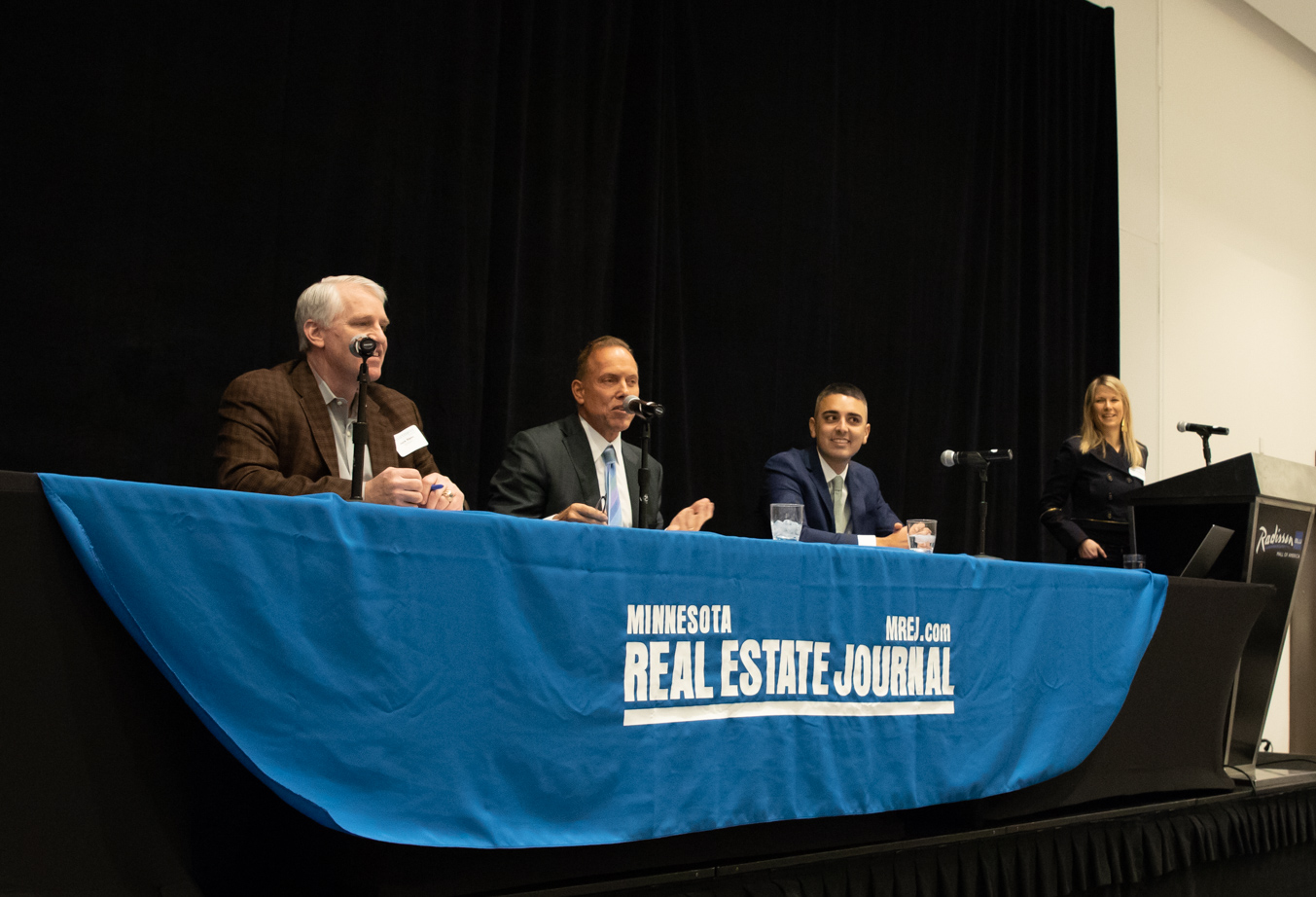The 2019 Apartment Summit set a record with of more than 725 attendees and leaders in the real estate industry inside the Radisson Blu in Bloomington. The panels, led by successful industry veterans, covered a wide range of topics and answered a number of questions. The event also included opportunities for networking, and earning credit for real estate continuing education. A visual of the event can be seen here.
The panels covered a range of topics including how Minnesota’s Apartment Market compares to the rest of the nation, what are the growing trends, what the future looks like for industry leaders, and what changes we should expect with deals. The first panel was focused on the state of the industry, moderated by Keith Collins, Executive Vice President of CBRE. Mary Bujold, President of Mayfield Research, was on the first panel. “We’re seeing larger demand in the suburbs. Prices for all products new going up and up.” Bujold also noted the importance of opportunity zones and the difficulties. “Opportunity zones are a driving force, along with workforce housing; are the next big thing. However, we don’t have good tools to always make affordable housing work.” Others on the panel claim that the Twin Cities are the best kept secret in terms of development. They emphasized finding well allocated real estate and always providing good service. “Local sellers account for a huge percentage of ownership in Minnesota. Looking at other cities like San Francisco or Portland, we have to be really thoughtful on an approach and zoning properly.” John Sebree, the National Director of Multi-Housing of Marcus and Millichap, believes that “Minneapolis is one of the best at handling the economy. The local government has to be smart when it comes to development.” Many of the brokers had a theme that perception changes quicker than reality.
The second panel focused on equity and debt solutions for apartment investors and developers, led by moderator Jim Hoopes, Senior Vice President of NorthMarq Capital. The panel discussed some of the effects of the government shutdown and how it affects loans. Some banks are unwilling to open up accounts with HUD, and they emphasized conversion risks and taking taking a proactive role. CBRE Senior Vice President Joel Torborg spoke about interest rates. “Our deposit rates don’t change as the rates of treasury change. Borrowers are seeing treasuries going down, and it will settle down.” The panel also discussed how college-type housing helps combat the issue of affordable housing, and how going green can reduce your rate with HUD.
Opportunity zones and tax reform was the main topic for the third panel, featuring three members of Wipfli, and Duane Lund, CEO of NAI Legacy. The panel discussed how it’s possible to change a 1031 to an opportunity zone in 180 days, and how to find these opportunity zones to invest in. Wipfli emphasized all real estate owners should pay attention to cost segregation within the tax reform. Duane Lund spoke about bonus depreciation and the possibilities, “There are opportunities to write off 100% on the first year. In fact, you can have numerous tax write-offs in the year of an acquisition.” Lund emphasized how much money is coming into the industry with opportunity zones. Danielle Lewis, Tax Manager at Wipfli, spoke on opportunity zones and all of the possibilities to tap into. “Opportunity zones really grew legs this past April and May. It allows real estate transactions to tap into investors sitting on capital gains.”
The fourth panel touched on how to operate an apartment building for success, moderated by Elin Michel-Midelfort, Vice President of The Excelsior Group. The changing and evolving landscape of modern expectations of tenants was a main point of conversation, also covering current trends in the apartment marketplace. Jack Sipes, Partner and Senior Vice President of Dominium, discussed affordable housing in the city. “We want to fit the community with affordable housing that’s not an eyesore. We feel that it’s important to create dignity where you live, which includes curb appeal, amenities, and being part of the community.” Managing Director of Real Estate of CRM at Greystar, Robby Mailatyar, talked about his clear vision to run a successful business. “I want to empower employees on the front line and go beyond the business transaction, which is the key ingredient to success.” Mailatyar also discussed how technology is key, which includes smart-home technology to play music and adjust lights at home. “We’re testing a self walk-through with sign-in and google maps to tour a property on their own time. I think this has potential schedule-wise, although I prefer to have human interaction.”
The fifth and final panel focused on developing, designing, and building a successful apartment project. Moderated by Sambatek Principal, Mark Anderson, the panel discussed the drivers for biggest potential growth in the Twin Cities. Topics also included how design will impact project success, construction trends, the importance of building a strong partnership with a municipality, and the future outlook for apartments in the Twin Cities. Development director Will O’Keefe at Bader Development is looking forward to the Calhoun Towers. “We put together a community and campus feeling. Hopefully it becomes a model development for transit-oriented buildings.” Mike Krych, a partner at BKV Group discussed the plans of micro units downtown with no parking units, but instead making a deal with an existing public lot. “Developers need to spend time with the design team. Design matters, which includes exterior, flexibility, amenities.” President of Development Tony Kuechle of Doran Companies spoke on how empty nesters made up a significant co-hort, specifically in downtown Hopkins. The amenities are used for grandchildren on a weekly basis, “This keeps families together every weekend.” Senior Vice President at Kraus-Anderson Development Matt Alexander emphasized the HUD program. “An architect and contractor that’s familiar with the HUD program is invaluable. Bring in the contractor early, work together, keep it efficient.” Joyce Sputnik, partner at bdh+young, spoke about community announcements within a building to bring the building together and generation Z. “Generation Z, the ones currently graduating high school and college might be more sedentary. Therefore, it’s worth reconsidering building big fitness centers inside apartment complexes. Know the demographic.” Finally, Senior Vice President Chris Sherman at Sherman Associates talked about how affordable housing has been their mission for the past 20 years. He currently has five developments in opportunity zones. “Unit mix is critical for success long-term, I view it as number one. We talk to the people living there to make sure we don’t make too many units.”


